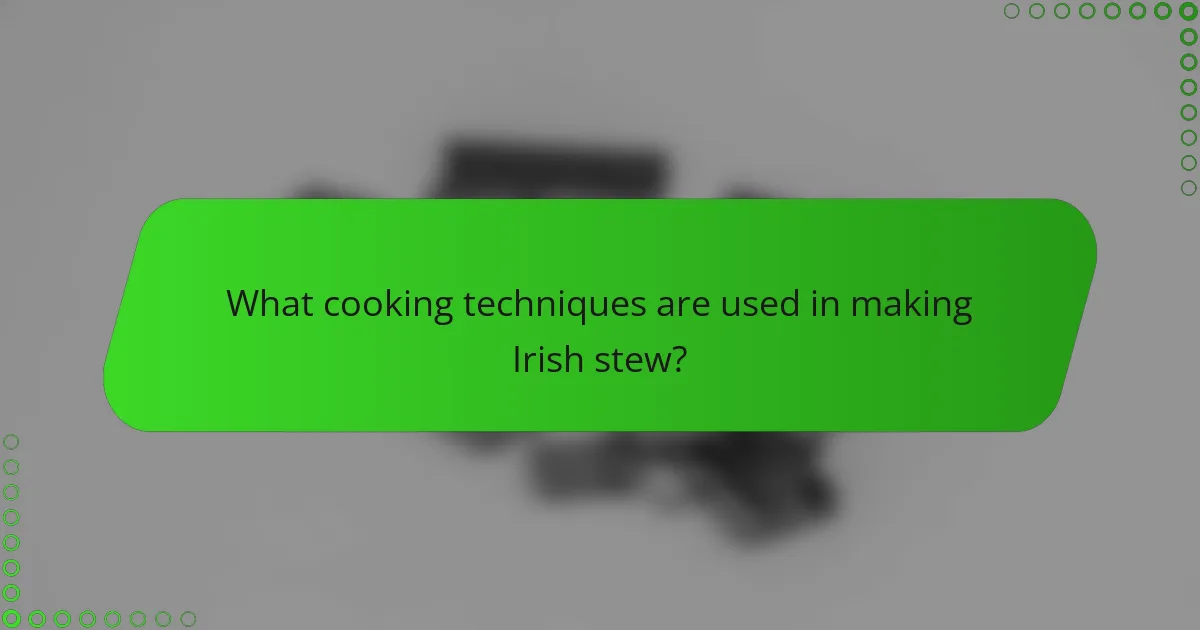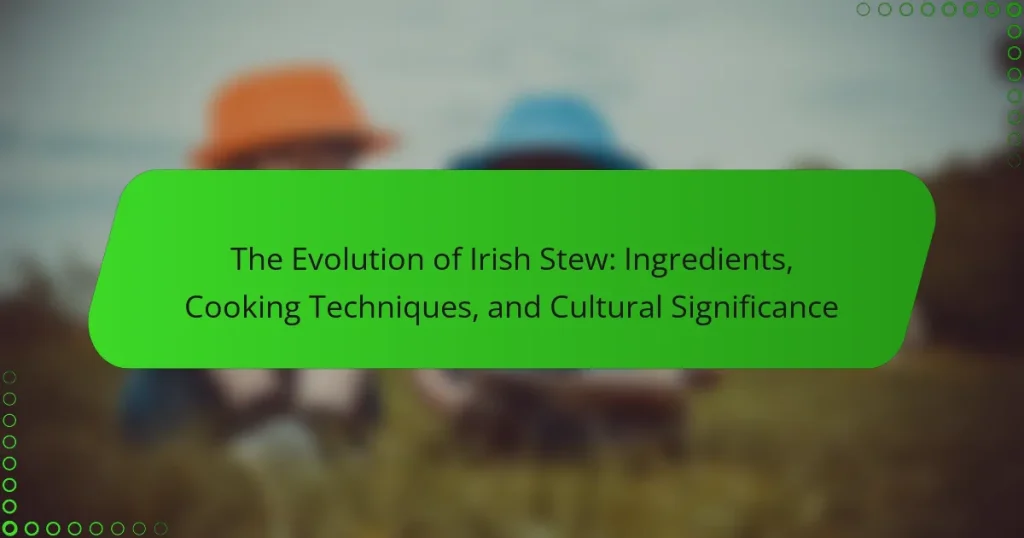Irish stew is a traditional Irish dish with origins dating back to the 18th century, initially created as a peasant meal using affordable ingredients such as lamb or mutton, potatoes, carrots, and onions. Over time, the dish evolved to incorporate beef, particularly influenced by the Great Famine in the mid-19th century, which solidified potatoes as a staple in Irish cuisine. This article explores the evolution of Irish stew, detailing its key ingredients, cooking techniques like simmering and layering flavors, and its cultural significance as a symbol of Irish heritage and community values. The significance of Irish stew in gatherings and its representation in literature further illustrate its role in reinforcing national identity.

What is the history of Irish stew?
Irish stew is a traditional dish that has roots dating back to the 18th century. It originated as a peasant meal in Ireland, utilizing inexpensive ingredients. The earliest versions typically included lamb or mutton, potatoes, carrots, and onions. These ingredients were readily available to rural families.
Over time, the dish evolved to include beef as a common variation. The Great Famine in the mid-19th century significantly influenced its popularity. During this period, potatoes became a staple food in Ireland, leading to their prominence in the stew.
Irish stew has been recognized for its simplicity and heartiness. It reflects the agricultural practices and available resources of Irish culture. Today, it is celebrated as a national dish, symbolizing Irish heritage and culinary tradition.
How has Irish stew evolved over the centuries?
Irish stew has evolved significantly over the centuries. Originally, it was a simple dish made with lamb or mutton, potatoes, onions, and water. This basic recipe dates back to the 18th century, reflecting the agrarian lifestyle of Ireland. As the dish gained popularity, variations emerged, incorporating different meats and vegetables based on availability. During the Great Famine in the 19th century, the reliance on potatoes became pronounced, as they were a staple food.
In the 20th century, Irish stew began to include beef and sometimes chicken, reflecting changes in agricultural practices and tastes. Modern recipes often add herbs like thyme and parsley, enhancing flavor profiles. Today, Irish stew is celebrated as a symbol of Irish heritage, often served in pubs and restaurants worldwide. Its evolution mirrors Ireland’s social and economic changes throughout history.
What are the origins of Irish stew?
Irish stew originated as a traditional dish in Ireland, primarily made with lamb or mutton, potatoes, carrots, and onions. Its roots can be traced back to the 18th century, reflecting the rural lifestyle of the Irish people. The stew was a practical solution for using leftover meat and vegetables. Historical records indicate that it was commonly prepared by families in one pot, making it a staple in Irish households. The simplicity of the ingredients highlights the agrarian society’s reliance on locally sourced produce. Over time, the dish evolved, incorporating various regional ingredients and cooking methods. Today, Irish stew is celebrated as a symbol of Irish cuisine and culture.
How did historical events influence the development of Irish stew?
Historical events significantly influenced the development of Irish stew. The Great Famine in the mid-19th century drastically affected food availability in Ireland. During this time, many families relied on simple, hearty meals to survive. Irish stew emerged as a way to utilize inexpensive ingredients like potatoes, onions, and meat scraps.
The introduction of the potato in the late 16th century also shaped the dish. Potatoes became a staple food, providing sustenance and bulk to stews. Additionally, the influence of British and Norman culinary practices introduced new cooking techniques and ingredients.
As a result, Irish stew evolved into a symbol of resilience and comfort. It reflects the socio-economic conditions and agricultural practices of Ireland throughout history. The dish remains a cultural icon, representing Irish heritage and community.
What are the traditional ingredients of Irish stew?
The traditional ingredients of Irish stew include lamb or mutton, potatoes, carrots, onions, and parsley. These components create a hearty and flavorful dish. Historically, Irish stew was made with whatever meat was available, often using tougher cuts that benefited from slow cooking. Potatoes became a staple ingredient after their introduction to Ireland in the late 16th century. Carrots and onions add sweetness and depth to the stew. Parsley is commonly used as a garnish, enhancing both flavor and presentation. This combination reflects Ireland’s agricultural heritage and resourcefulness in using local produce.
How do different regions in Ireland influence ingredient choices?
Different regions in Ireland significantly influence ingredient choices for Irish stew. Coastal areas often utilize seafood due to proximity to the ocean. For example, regions like Galway incorporate fish and shellfish into their stews. In contrast, inland areas focus on meat and root vegetables. Counties such as Kerry emphasize lamb and potatoes, reflecting agricultural practices. Additionally, local climate affects available produce. Warmer regions may have a wider variety of vegetables. Historical trade routes also introduce unique spices and herbs. Overall, regional diversity shapes the flavors and ingredients of Irish stew.
What role do seasonal ingredients play in Irish stew?
Seasonal ingredients play a crucial role in Irish stew by enhancing flavor and nutrition. They provide freshness and reflect the agricultural cycles of Ireland. Ingredients like root vegetables in winter and fresh herbs in spring contribute to the stew’s depth. Seasonal produce ensures the dish remains vibrant and relevant throughout the year. Using local and seasonal ingredients also supports sustainable farming practices. This connection to the land is historically significant in Irish culture. Seasonal variations in ingredients can lead to unique family recipes passed down through generations. Thus, seasonal ingredients are integral to both the taste and cultural heritage of Irish stew.

What cooking techniques are used in making Irish stew?
Irish stew is traditionally made using techniques such as simmering and layering flavors. Simmering involves cooking the ingredients slowly in liquid, allowing them to tenderize and develop rich flavors. This technique is essential for breaking down tougher cuts of meat, commonly used in stews. Layering flavors is achieved by adding ingredients in stages, starting with browning the meat. This process enhances the overall taste of the dish. Additionally, some recipes may include sautéing vegetables before adding them to the stew. This method helps to release their natural sugars and deepen the flavor profile. Cooking Irish stew often requires patience, as the longer it simmers, the more flavorful it becomes.
How do cooking methods vary across different recipes?
Cooking methods vary across different recipes based on techniques and desired outcomes. For example, Irish stew typically involves simmering ingredients for a long duration to enhance flavors. In contrast, stir-frying requires high heat and quick cooking to preserve texture and nutrients. Baking is another method, often used for casseroles, which allows even cooking and flavor melding. Additionally, grilling imparts a smoky flavor and char, which is not present in boiling or steaming. Each method influences the final taste, texture, and nutritional profile of the dish. Thus, the choice of cooking method is crucial in defining the character of a recipe.
What are the common cooking methods for Irish stew?
The common cooking methods for Irish stew include simmering, slow cooking, and baking. Simmering involves cooking the stew ingredients in a pot over low heat. This method allows flavors to meld over time. Slow cooking uses a slow cooker to maintain a low temperature for several hours. Baking can also be used, where the stew is placed in an oven-safe dish and cooked until tender. These methods are traditional in Irish cuisine and enhance the stew’s rich flavors.
How does slow cooking affect the flavor profile of Irish stew?
Slow cooking enhances the flavor profile of Irish stew by allowing ingredients to meld together. The prolonged cooking time breaks down tough cuts of meat, making them tender. This process releases natural juices and flavors into the broth. Vegetables, such as potatoes and carrots, also soften and contribute their sweetness. Herbs and spices infuse gradually, creating a more complex taste. The Maillard reaction occurs, adding depth and richness to the stew. Overall, slow cooking results in a harmonious blend of flavors that is characteristic of traditional Irish stew.
What tools and equipment are essential for preparing Irish stew?
Essential tools and equipment for preparing Irish stew include a heavy-bottomed pot or Dutch oven. This type of pot provides even heat distribution, essential for slow cooking. A cutting board is necessary for chopping vegetables and meat. A sharp knife is also crucial for precise cutting. Measuring cups and spoons help ensure accurate ingredient portions. A ladle is useful for serving the stew. Finally, a wooden spoon is ideal for stirring the ingredients during cooking. These tools facilitate the traditional preparation of Irish stew, ensuring a flavorful and well-cooked dish.
What type of pot is best for cooking Irish stew?
A heavy-bottomed pot, such as a Dutch oven, is best for cooking Irish stew. This type of pot provides even heat distribution. It retains heat well, which is essential for slow cooking. A Dutch oven can be used on both stovetops and in ovens. Its tight-fitting lid helps to trap moisture and flavors. Cooking Irish stew in such a pot allows for tender meat and well-cooked vegetables. Many traditional recipes recommend this pot for optimal results. The use of a heavy pot has been a common practice in Irish cooking for generations.
How do modern kitchen appliances change the preparation of Irish stew?
Modern kitchen appliances streamline the preparation of Irish stew. They allow for quicker cooking times and enhanced flavor infusion. Pressure cookers can significantly reduce cooking duration, making the stew tender in under an hour. Slow cookers enable a hands-off approach, allowing flavors to meld over several hours. Immersion blenders can puree ingredients directly in the pot, creating a smoother texture. Multi-cookers combine various functions, offering versatility in cooking methods. These appliances also promote consistent results, making it easier for home cooks to replicate traditional flavors. The convenience of these tools encourages more frequent preparation of Irish stew in contemporary kitchens.

What is the cultural significance of Irish stew?
Irish stew holds significant cultural importance as a traditional dish in Ireland. It symbolizes Irish hospitality and communal values. Historically, it was a staple for the working class, made from inexpensive ingredients like lamb or beef, potatoes, and root vegetables. This dish reflects the agricultural heritage of Ireland, showcasing locally sourced produce. Irish stew is often served during gatherings and celebrations, reinforcing community bonds. The dish has evolved over time, yet it remains a symbol of national identity. Its presence in Irish literature and folklore further underscores its cultural relevance.
How does Irish stew reflect Irish identity and heritage?
Irish stew reflects Irish identity and heritage through its ingredients and traditional preparation methods. The dish typically includes lamb or beef, potatoes, carrots, and onions. These ingredients are staples in Irish agriculture and cuisine. Historically, Irish stew was a meal for the working class, emphasizing frugality and resourcefulness.
The use of locally sourced ingredients showcases the connection to the land. The dish’s simplicity mirrors the Irish spirit of resilience and community. Irish stew is often served at family gatherings and celebrations, reinforcing its cultural significance.
In Ireland, it is recognized as a national dish, symbolizing national pride. The preparation of Irish stew has been passed down through generations, preserving culinary traditions. This continuity reflects the deep-rooted heritage of the Irish people.
What role does Irish stew play in traditional Irish celebrations?
Irish stew is a traditional dish served during Irish celebrations. It symbolizes hospitality and community spirit in Irish culture. Typically made with lamb or beef, potatoes, and root vegetables, it reflects the agricultural heritage of Ireland. Irish stew is often prepared for gatherings like St. Patrick’s Day and family reunions. The dish fosters a sense of togetherness among those who share it. Its warm, hearty nature makes it a comforting meal during festive occasions. Historically, Irish stew has been a staple for both the rich and poor, showcasing its significance across social classes. The dish’s enduring popularity in celebrations highlights its role in preserving Irish culinary traditions.
How is Irish stew perceived in contemporary Irish culture?
Irish stew is perceived as a symbol of traditional Irish comfort food in contemporary Irish culture. It reflects the country’s culinary heritage and is often associated with family gatherings and celebrations. Many Irish people view it as a dish that showcases the simplicity and heartiness of local ingredients. The stew typically includes lamb or beef, potatoes, carrots, and onions. In recent years, there has been a revival of interest in traditional recipes. This has led to variations that incorporate modern cooking techniques and local produce. Irish stew is frequently featured on menus in pubs and restaurants across Ireland. It is also a popular choice for St. Patrick’s Day celebrations, emphasizing its cultural significance. Overall, Irish stew remains a cherished dish that connects people to their roots and traditions.
What are some modern variations of Irish stew?
Modern variations of Irish stew include several innovative takes on the traditional recipe. One popular variation is the use of lamb or beef instead of the classic mutton. Some recipes incorporate root vegetables like parsnips and turnips for added flavor. Others may include a variety of herbs, such as thyme and rosemary, to enhance the dish’s aroma.
A contemporary twist features the addition of stout or ale, which deepens the stew’s richness. Vegetarian versions replace meat with hearty ingredients like mushrooms and lentils. Seafood variations use fish and shellfish, offering a lighter alternative.
These adaptations reflect changing tastes and dietary preferences while maintaining the essence of the original dish.
How do contemporary chefs reinterpret traditional Irish stew recipes?
Contemporary chefs reinterpret traditional Irish stew recipes by incorporating modern ingredients and techniques. They often use a variety of meats beyond lamb or beef, such as chicken or seafood. Seasonal vegetables are emphasized, enhancing freshness and flavor. Chefs may also introduce international spices and herbs to create unique flavor profiles. Techniques like sous-vide cooking or pressure cooking are applied for precision and efficiency. Some chefs focus on plant-based versions, catering to dietary preferences. These reinterpretations maintain the essence of traditional Irish stew while reflecting contemporary culinary trends. This evolution showcases the adaptability of Irish cuisine in a global context.
What unique ingredients are being incorporated into Irish stew today?
Modern Irish stew incorporates unique ingredients such as lamb shanks, sweet potatoes, and kale. These ingredients enhance the traditional recipe, adding depth of flavor and nutritional value. Lamb shanks provide a richer taste compared to the classic cuts. Sweet potatoes introduce a subtle sweetness and vibrant color. Kale adds a nutritious green element, reflecting contemporary health trends. The inclusion of these ingredients demonstrates the evolution of Irish stew in response to changing culinary preferences.
What tips can enhance the preparation of Irish stew?
Use quality ingredients to enhance Irish stew. Fresh, locally sourced meat and vegetables improve flavor. Choose a combination of lamb and beef for depth. Brown the meat before stewing to develop rich flavors. Add herbs like thyme and bay leaves for aromatic qualities. Use a good stock or broth as the base for richness. Simmer slowly to tenderize the meat and meld flavors. Incorporate root vegetables like carrots and potatoes for texture. Let the stew rest before serving to deepen the taste.
The main entity of the article is Irish stew, a traditional dish with a rich history dating back to the 18th century. The article explores the evolution of Irish stew, detailing its origins, traditional ingredients, and the influence of historical events such as the Great Famine on its development. It also examines the cooking techniques used, regional variations, and the cultural significance of the dish in Irish society. Additionally, modern adaptations and tips for enhancing the preparation of Irish stew are discussed, highlighting its enduring relevance in contemporary cuisine.


